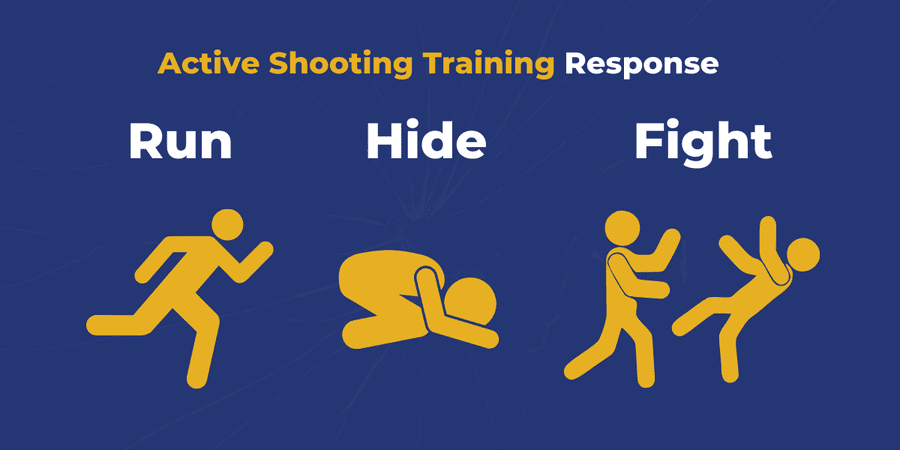Just How Active Shooter Training Can Save Lives in Crisis Situations
Just How Active Shooter Training Can Save Lives in Crisis Situations
Blog Article
The Vital Function of Active Shooter Training in Enhancing Emergency Reaction Strategies in Numerous Settings
Energetic shooter training has actually arised as a fundamental part in refining emergency response strategies throughout varied setups, from educational institutions to business settings. The efficiency of such training pivots on various variables, including the specific context in which it is carried out and the ongoing commitment to enhancement.
Relevance of Active Shooter Training
In an era marked by boosting problems over public safety, the significance of active shooter training can not be overstated. As occurrences of weapon physical violence in public rooms continue to rise, organizations across different sectorsâEUR" academic organizations, workplaces, and public venuesâEUR" are recognizing the requirement of preparing their workers and areas for such emergency situations. Energetic shooter training furnishes people with critical skills and knowledge to respond effectively in dangerous circumstances, possibly lessening casualties and conserving lives.
The training not just focuses on prompt feedback activities, such as emptying and safeguarding in location, but likewise promotes a culture of understanding and preparedness. By participating in practical simulations and conversations, individuals can determine possible susceptabilities within their setting and establish techniques for mitigating risks. Such training boosts interaction and coordination amongst group members and initial -responders, guaranteeing an extra unified method during situations.

Key Parts of Effective Educating
Effective active shooter training consists of numerous essential parts that enhance preparedness and action capabilities. Firstly, realistic scenario-based simulations are critical. These workouts submerse individuals in high-stress situations that simulate possible active shooter events, enabling them to exercise decision-making and physical feedbacks under pressure.
Additionally, training should consist of an extensive understanding of communication protocols. Participants must be skilled in just how to pass on critical information to legislation enforcement and fellow people throughout an incident. This includes utilizing emergency notifies and comprehending the hierarchy.
One more necessary component is the incorporation of mental health awareness. Training should address the psychological impact of active shooter situations, furnishing individuals with coping strategies and sources to sustain their psychological wellness post-incident.
Furthermore, normal refresher courses are vital to guarantee that skills continue to be sharp and expertise is updated. This continuous education reinforces the significance of preparedness and cultivates a society of security within organizations.
Training for Different Settings
Active shooter training should be tailored to the specific settings in which individuals operate, as each establishing presents special challenges and characteristics. Training in a business office will certainly vary substantially from that in a school, purchasing mall, or health care center. Each atmosphere necessitates a tailored method that considers factors such as format, populace thickness, and offered escape paths.
In academic institutions, training programs must emphasize lockdown procedures, communication methods with law enforcement, and strategies for protecting pupils. On the other hand, in company settings, training may concentrate on evacuation approaches, acknowledging dubious behaviors, and utilizing readily available resources for protection or shelter-in-place scenarios.
Additionally, public places like malls or showing off occasions call for comprehensive crowd monitoring strategies, with a focus on fast feedback coordination among protection personnel and local police.
In medical care settings, training should attend to anonymous specific vulnerabilities, such as the presence of clients that might call for prompt support. By understanding the unique attributes of each setting, companies can create reliable training components that boost readiness and boost general security, making certain that people are outfitted to react suitably in diverse situation scenarios.

Building a Society of Recognition
Creating a culture of recognition is basic to enhancing precaution in any kind of setting, as it equips individuals to acknowledge prospective risks and respond proactively. This culture requires constant education, open interaction, and the integration of safety and security procedures into everyday routines.
Organizations ought to focus on active shooter training as component of their overarching safety method, ensuring that all workers understand the specific dangers linked with their environment. Routine training sessions grow watchfulness and knowledge with emergency procedures, motivating individuals to stay sharp to uncommon behaviors or conditions.
Moreover, promoting a society of awareness involves producing an environment where reporting dubious activity is both encouraged and normalized. active shooter training. Staff members must feel comfortable sharing their worries without my explanation anxiety of retribution. This can be attained through clear channels of communication and helpful management
In addition, engaging in community partnerships can increase understanding past organizational boundaries, promoting a shared obligation for security. Efforts such as workshops, drills, and informative sessions can additionally boost cumulative watchfulness. Inevitably, constructing a culture of understanding not only prepares people for possible situations however additionally reinforces the overall durability of the organization against risks.
Assessing Training Effectiveness
While regular training sessions are important for preparedness, assessing their effectiveness is equally vital to make certain that employees are outfitted with the needed skills and knowledge to respond suitably in case of an energetic shooter circumstance. Assessment processes need to consist of both qualitative and quantitative assessments to gauge the influence of training on action abilities.
Surveys and feedback from individuals can supply important insights right into the training's significance and applicability. Furthermore, conducting sensible drills and simulations enables organizations to observe real-time decision-making and synergy under stress. Analyzing the end results of these workouts assists determine strengths and locations for renovation.

Including stakeholders, consisting of police and emergency responders, website here in the assessment procedure can boost trustworthiness and give an extensive viewpoint on training efficiency (active shooter training). Ultimately, a systematic examination technique makes certain that active shooter training remains an important element of an organization's emergency situation action approach, fostering a safer environment for all
Final Thought
Energetic shooter training is crucial in fortifying emergency response techniques across varied atmospheres. Eventually, the execution and analysis of effective training programs add considerably to reducing the effect of active shooter situations, consequently securing lives and enhancing community strength.
Report this page